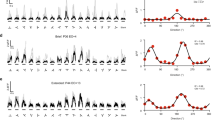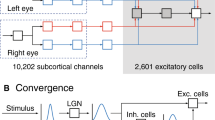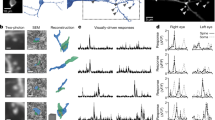Abstract
We found that in mice, following eye opening, fast-spiking, parvalbumin-positive GABAergic interneurons had well-defined orientation tuning preferences and that subsequent visual experience broadened this tuning. Broad inhibitory tuning was not required for the developmental sharpening of excitatory tuning but did precede binocular matching of excitatory orientation tuning. We propose that experience-dependent broadening of inhibition is a candidate for initiating the critical period of excitatory binocular plasticity in developing visual cortex.
This is a preview of subscription content, access via your institution
Access options
Subscribe to this journal
Receive 12 print issues and online access
$209.00 per year
only $17.42 per issue
Buy this article
- Purchase on Springer Link
- Instant access to full article PDF
Prices may be subject to local taxes which are calculated during checkout


Similar content being viewed by others
References
Ma, W.P. et al. J. Neurosci. 30, 14371–14379 (2010).
Alonso, J.M. & Swadlow, H.A. J. Neurophysiol. 94, 26–32 (2005).
Hull, C. & Scanziani, M. Nat. Neurosci. 10, 400–402 (2007).
Klausberger, T. & Somogyi, P. Science 321, 53–57 (2008).
Hensch, T.K. Nat. Rev. Neurosci. 6, 877–888 (2005).
Gogolla, N. et al. J. Neurodev. Disord. 1, 172–181 (2009).
Gonzalez-Burgos, G., Hashimoto, T. & Lewis, D.A. Curr. Psychiatry Rep. 12, 335–344 (2010).
Gordon, J.A. & Stryker, M.P. J. Neurosci. 16, 3274–3286 (1996).
Liu, B.H. et al. J. Neurosci. 29, 10520–10532 (2009).
Ringach, D.L., Shapley, R.M. & Hawken, M.J. J. Neurosci. 22, 5639–5651 (2002).
Kerlin, A.M., Andermann, M.L., Berezovskii, V.K. & Reid, R.C. Neuron 67, 858–871 (2010).
Bock, D.D. et al. Nature 471, 177–182 (2011).
Zariwala, H.A. et al. Front. Syst. Neurosci. 4, 162 (2011).
White, L.E., Coppola, D.M. & Fitzpatrick, D. Nature 411, 1049–1052 (2001).
Wang, B.S., Sarnaik, R. & Cang, J. Neuron 65, 246–256 (2010).
Acknowledgements
We thank A. Silva for use of equipment and space, P. Golshani and D. Chow for technical training and discussion, D. Ringach and R. Gruver for help with data analysis, and T. Otis, S. Smith, M. Stryker and D. Ringach for comments on earlier versions of the manuscript. This work was supported by the US National Eye Institute (grants EY016052 and EY016052S2).
Author information
Authors and Affiliations
Contributions
S.J.K. and J.T.T. designed the experiments and wrote the manuscript. S.J.K. carried out the parvalbumin-positive experiments and analyzed the data, and S.J.K. and E.T. carried out the RFP-negative experiments and analyzed the data.
Corresponding author
Ethics declarations
Competing interests
The authors declare no competing financial interests.
Supplementary information
Supplementary Text and Figures
Supplementary Figures 1–7 and Methods (PDF 1203 kb)
Rights and permissions
About this article
Cite this article
Kuhlman, S., Tring, E. & Trachtenberg, J. Fast-spiking interneurons have an initial orientation bias that is lost with vision. Nat Neurosci 14, 1121–1123 (2011). https://doi.org/10.1038/nn.2890
Received:
Accepted:
Published:
Issue Date:
DOI: https://doi.org/10.1038/nn.2890
This article is cited by
-
Development of visual response selectivity in cortical GABAergic interneurons
Nature Communications (2022)
-
Existing function in primary visual cortex is not perturbed by new skill acquisition of a non-matched sensory task
Nature Communications (2022)
-
Juvenile depletion of microglia reduces orientation but not high spatial frequency selectivity in mouse V1
Scientific Reports (2022)
-
Stimulus-dependent representational drift in primary visual cortex
Nature Communications (2021)
-
Precocious deposition of perineuronal nets on Parvalbumin inhibitory neurons transplanted into adult visual cortex
Scientific Reports (2018)



